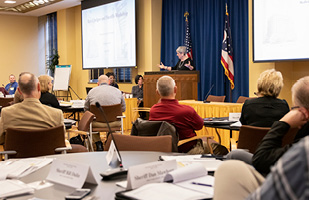Rural Courts, Sheriffs Convene with Feds to Combat Opioids

Ohio Supreme Court Chief Justice Maureen O'Connor welcomes judges, sheriffs, and treatment providers taking part in a workshop to help rural communities tackle the opioid crisis.

Ohio Supreme Court Chief Justice Maureen O'Connor welcomes judges, sheriffs, and treatment providers taking part in a workshop to help rural communities tackle the opioid crisis.
The opioid epidemic has created a crime and treatment crisis for all kinds of American communities. But the ones that may be most affected are small and rural jurisdictions.
In an effort to help courts, law enforcement, and treatment providers address addiction-related issues in these areas, the Bureau of Justice Assistance (BJA) – a branch of the U.S. Department of Justice (DOJ) – held a three-day workshop at the Thomas J. Moyer Ohio Judicial Center. The mission was to share ideas for each group to maximize their budgets and increase funding, staffing, and treatment.
Joining the federal and regional representatives this week were sheriffs, judges, and treatment providers from across the Great Lakes region – Ohio, Michigan, Indiana, Illinois, Wisconsin, and Minnesota.
Given their smaller staffs and minimal contact with external specialists, attendees focused on the BJA’s Comprehensive Opioid Abuse Program, giving them the opportunity to hear success stories and implement best practices.
“It’s nice to collaborate with other communities, other colleagues who are in similar roles,” said Judge Amy Gierhart, a circuit court judge in Tuscola County, Michigan.
A big part of the dialogue between the federal representatives and local agencies are systemic issues that many times prevents courts, sheriff’s departments, and treatment agencies from receiving available federal and state funds. Last year, the DOJ awarded $320 million to combat the opioid crisis. Of that, more than $16 million went to Ohio.
In smaller communities, sheriffs not only lack administrative support or understanding on how to apply for grants, but also are more involved in the day-to-day policing of their communities, from responding to calls and working investigations. For them, a big goal is simplifying the bureaucratic process.
“Folks from the federal government can take back to [legislators] to rewrite some of the strings-attached grant funding – or different sorts of things of that nature – to help those of us in rural communities be able to fund programs or potentially hire people to implement programs,” said Paulding County Sheriff Jason Landers.
Having grown up in northwest Ohio, he’s seen the gravity of addiction in many forms, impacting all sectors of the socioeconomic spectrum. Following the proven methods that coincide with a communal effort of policing, incarceration, and treatment, the sheriff simply wants to maximize what his department can do to help those dealing with the dark depths of addiction.
“To keep folks that truly want to be recovered on a better path of staying sober and living that productive life, and getting them back into society, working, to become good parents again, to become good children again,” Landers said.


